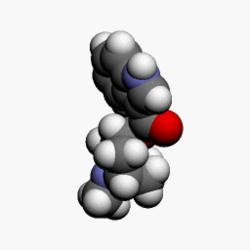| 5-HT2A |
- Agonists: 25H/NB series (e.g., 25I-NBF, 25I-NBMD, 25I-NBOH, 25I-NBOMe, 25B-NBOMe, 25C-NBOMe, 25TFM-NBOMe, 2CBCB-NBOMe, 25CN-NBOH, 2CBFly-NBOMe)
- 2Cs (e.g., 2C-B, 2C-E, 2C-I, 2C-T-2, 2C-T-7, 2C-T-21)
- 2C-B-FLY
- 2CB-Ind
- 5-Methoxytryptamines (5-MeO-DET, 5-MeO-DiPT, 5-MeO-DMT, 5-MeO-DPT, 5-MT)
- α-Alkyltryptamines (e.g., 5-Cl-αMT, 5-Fl-αMT, 5-MeO-αET, 5-MeO-αMT, α-Me-5-HT, αET, αMT)
- AL-34662
- AL-37350A
- Bromo-DragonFLY
- Dimemebfe
- DMBMPP
- DOx (e.g., DOB, DOC, DOI, DOM)
- Efavirenz
- Ergolines (e.g., 1P-LSD, ALD-52, bromocriptine, cabergoline, ergine (LSA), ergotamine, lisuride, LA-SS-Az, LSB, LSD, LSD-Pip, LSH, LSP, methylergometrine (methylergonovine), pergolide)
- Flumexadol
- Jimscaline
- Lorcaserin
- MDxx (e.g., MDA, MDMA, MDOH, MMDA)
- O-4310
- Oxaflozane
- PHA-57378
- PNU-22394
- PNU-181731
- RH-34
- Phenethylamines (e.g., lophophine, mescaline)
- Piperazines (e.g., BZP, mCPP, quipazine, TFMPP)
- Serotonin (5-HT)
- TCB-2
- TFMFly
- Tryptamines (e.g., 5-BT, 5-CT, bufotenin, DET, DiPT, DMT, DPT, psilocin, psilocybin, tryptamine)
|
|
- Antagonists: 5-I-R91150
- 5-MeO-NBpBrT
- AC-90179
- Adatanserin
- Altanserin
- AMDA
- APD-215
- Atypical antipsychotics (e.g., amperozide, aripiprazole, asenapine, blonanserin, carpipramine, clocapramine, clorotepine, clozapine, fluperlapine, gevotroline, iloperidone, melperone, mosapramine, ocaperidone, olanzapine, paliperidone, quetiapine, risperidone, sertindole, zicronapine, ziprasidone, zotepine)
- Cinanserin
- CSP-2503
- Cyproheptadine
- Deramciclane
- Dotarizine
- Eplivanserin
- Ergolines (e.g., amesergide, LY-53857, LY-215840, mesulergine, metergoline, methysergide, sergolexole)
- Etoperidone
- Fananserin
- Flibanserin
- Glemanserin
- Irindalone
- Ketanserin
- KML-010
- Lubazodone
- LY-393558
- Medifoxamine
- Mepiprazole
- Metitepine (methiothepin)
- MIN-101
- Naftidrofuryl
- Nantenine
- Nefazodone
- Pelanserin
- Phenoxybenzamine
- Pimavanserin
- Pirenperone
- Pizotifen
- Pruvanserin
- Rauwolscine
- Ritanserin
- S-14671
- Sarpogrelate
- Setoperone
- Spiperone
- Spiramide
- SR-46349B
- TGBA01AD
- Teniloxazine
- Temanogrel
- Tetracyclic antidepressants (e.g., amoxapine, aptazapine, esmirtazapine, maprotiline, mianserin, mirtazapine)
- Trazodone
- Tricyclic antidepressants (e.g., amitriptyline)
- Typical antipsychotics (e.g., chlorpromazine, fluphenazine, haloperidol, loxapine, perphenazine, pimozide, pipamperone, prochlorperazine, thioridazine, thiothixene, trifluoperazine)
- Volinanserin
- Xylamidine
- Yohimbine
|
|
|
|
|
|
| 5-HT2B |
- Agonists: 4-Methylaminorex
- Aminorex
- Amphetamines (eg., chlorphentermine, cloforex, dexfenfluramine, fenfluramine, levofenfluramine, norfenfluramine)
- BW-723C86
- DOx (e.g., DOB, DOC, DOI, DOM)
- Ergolines (e.g., cabergoline, dihydroergocryptine, dihydroergotamine, ergotamine, methylergometrine (methylergonovine), methysergide, pergolide)
- MDxx (e.g., MDA, MDMA, MDOH, MMDA)
- Piperazines (e.g., mCPP)
- PNU-22394
- Ro60-0175
- Serotonin (5-HT)
- Tryptamines (e.g., 5-BT, 5-CT, 5-MT, α-Me-5-HT, bufotenin, DET, DiPT, DMT, DPT, psilocin, psilocybin, tryptamine)
|
|
|
|
|
|
|
|
|
| 5-HT2C |
- Agonists: 2Cs (e.g., 2C-B, 2C-E, 2C-I, 2C-T-2, 2C-T-7, 2C-T-21)
- 5-Methoxytryptamines (5-MeO-DET, 5-MeO-DiPT, 5-MeO-DMT, 5-MeO-DPT, 5-MT)
- α-Alkyltryptamines (e.g., 5-Cl-αMT, 5-Fl-αMT, 5-MeO-αET, 5-MeO-αMT, α-Me-5-HT, αET, αMT)
- A-372159
- AL-38022A
- Alstonine
- CP-809101
- Dimemebfe
- DOx (e.g., DOB, DOC, DOI, DOM)
- Ergolines (e.g., ALD-52, cabergoline, dihydroergotamine, ergine (LSA), ergotamine, lisuride, LA-SS-Az, LSB, LSD, LSD-Pip, LSH, LSP, pergolide)
- Flumexadol
- Lorcaserin
- MDxx (e.g., MDA, MDMA, MDOH, MMDA)
- MK-212
- Org 12962
- Org 37684
- Oxaflozane
- PHA-57378
- Phenethylamines (e.g., lophophine, mescaline)
- Piperazines (e.g., aripiprazole, BZP, mCPP, quipazine, TFMPP)
- PNU-22394
- PNU-181731
- Ro60-0175
- Ro60-0213
- Serotonin (5-HT)
- Tryptamines (e.g., 5-BT, 5-CT, bufotenin, DET, DiPT, DMT, DPT, psilocin, psilocybin, tryptamine)
- Vabicaserin
- WAY-629
- WAY-161503
- YM-348
|
|
- Antagonists: Adatanserin
- Agomelatine
- Atypical antipsychotics (e.g., asenapine, clorotepine, clozapine, fluperlapine, iloperidone, melperone, olanzapine, paliperidone, quetiapine, risperidone, sertindole, ziprasidone, zotepine)
- Captodiame
- CEPC
- Cinanserin
- Cyproheptadine
- Deramciclane
- Dotarizine
- Eltoprazine
- Ergolines (e.g., amesergide, bromocriptine, LY-53857, LY-215840, mesulergine, metergoline, methysergide, sergolexole)
- Etoperidone
- Fluoxetine
- FR-260010
- Irindalone
- Ketanserin
- Ketotifen
- Latrepirdine (dimebolin)
- Medifoxamine
- Metitepine (methiothepin)
- Nefazodone
- Pirenperone
- Pizotifen
- Propranolol
- Ritanserin
- RS-102221
- S-14671
- SB-200646
- SB-206553
- SB-221284
- SB-228357
- SB-242084
- SB-243213
- SDZ SER-082
- Tedatioxetine
- Tetracyclic antidepressants (e.g., amoxapine, aptazapine, esmirtazapine, maprotiline, mianserin, mirtazapine)
- TIK-301
- Trazodone
- Tricyclic antidepressants (e.g., amitriptyline, nortriptyline)
- Typical antipsychotics (e.g., chlorpromazine, loxapine, pimozide, pipamperone, thioridazine)
- Xylamidine
|
|
|
|
|
|

